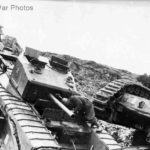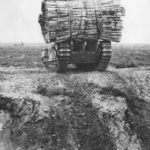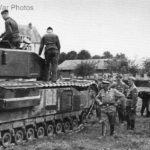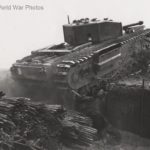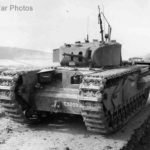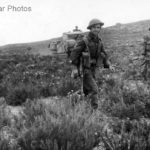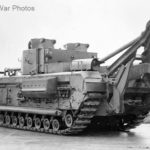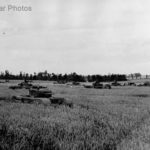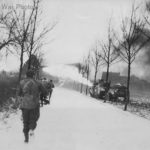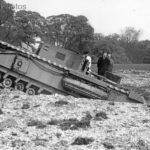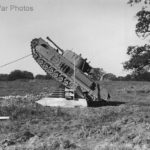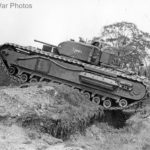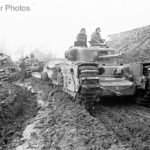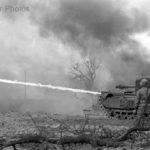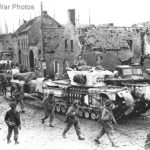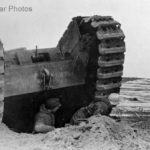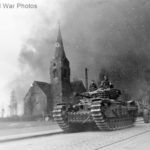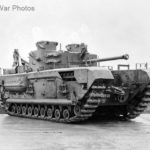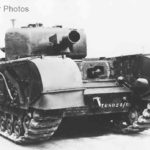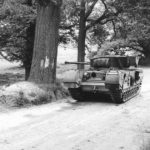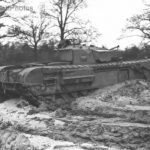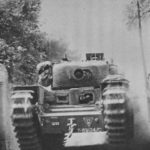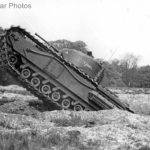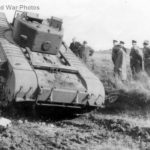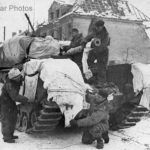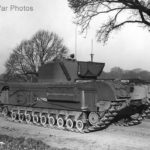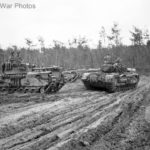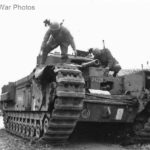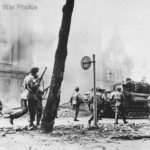Churchill Mk II with crane
Churchill Mk III tank and Bersaglieri in Tunisia 1943 2
Churchill AVRE with fascine on tilt forward cradle
Churchill ARV and Ram tank at Aborfield, 23 April 1943
Churchill tank maintenance ,Normandy August 1944
Churchills of the 11th Armoured Division 24 March 1945
Churchill tank crossing a Bailey bridge, 1944
A column of Churchill Crocodile tanks
M19 Tank Transporter carrying a Churchill
Churchill Mk I during trials
A lend-lease Churchill IV #505 “For Soviet Ukraine” of the 48th Separate Guards Breakthrough Tank Regiment, Kursk July 1943
Captured Churchill Mk III tank after Dieppe raid, 1942
Churchill Mk III T32149 during field trials
Churchill Mk II tank 1943
Churchills NW Europe 1944
Churchill Mk III support Biritsh Army infantry, Libya 1943
British heavy infantry tanks Churchill Mk II
Churchills of the 6th Guards Tank Brigade November 1944
Churchill ARV Mk II
Churchill Mk IV and VI tanks near Caen 1944
Churchill Crocodile Mk IV flame throwing tank fires at enemy positions. British infantrymen move along the road to St. Joost, in the Sittard battle area in Holland
Italian Bersaglieri and captured Churchill, Tunisia 1943
The first prototype of the infantry tank A22 during trials 1940
Churchill Mk VII during field trials, England 2
Churchill Mk IV of North Irish Horse crossing the Senio River over two Churchill Ark, April 1945
Churchill Mk I tank T30971 during field trials
Churchills Mk VII 1944/45
Knocked out Churchills Mk III Tunisia 1943
Churchill Mk VII Crocodile in action 1944
Churchill Mk VII Crocodile of 141st RAC in Höngen, Germany
German soldiers taking cover behind Soviet Churchill, Eastern Front
British Churchill Crocodile in Oberhausen-Sterkrade, Germany 31 March 1945
Churchill ARV Mk II 2
A lend-lease tank Churchill Mk IV #215, 1943
Churchill Mk V CS during field trials
Churchill Mk IV AVRE T68024/B
Churchill Ark (Armoured Ramp Carrier) and Sherman 52 “Spiteful”
Canadian Churchill Mk III named Betty Dieppe 1942
Tank Churchill Mk VII 4
Churchill Mk II during field trials 2
Churchill Mk IV AVRE T-69124/C of 5th Assault Regiment, Royal Engineers, 79th Armoured Division
Churchill Mk VII during field trials
Tank Churchill Mk IV AVRE Germany 1945
Churchill VI of 6th Guards Tank Brigade Holland 1945
Churchills Mk III of the “Kingforce” North Africa 1942
Canadian Churchills Mk II
Gun Carrier, 3-inch, Mk I, Churchill (A22D)
Churchill Mk II T68495
Churchill Mk IV tank Normandy 1944
Churchill Mk III
Churchill Mk I T-30971 during field trials
Churchill Mk IV England 1942
Churchills ETO
Churchill Mk II on heavy tank transporter M19. M20 Diamond T Model 980 truck and 12-wheel M9 trailer.
Churchill Crocodile in action color photo
Churchill AVRE
Polish Churchills Mk II 1942/43
Churchill crew use white bed sheets to help camouflage their tank
Churchill Mk VII
Canadian Churchill Mk III named Bert, Dieppe 1942
Churchill AVRE with applique armour carrying a fascine
Churchills Mk VII 1944
Russian Churchill IV of 36th Guards Tank Regiment Prohorovka 1943
Italian Bersaglieri and captured Churchill, Tunisia 1943 2
U.S. 17th Airborne and British 6th Guards with Churchill tank named Thunderbolt in Munster
Churchills NW Europe 1944 2
Heavy tank Churchill Mk III Tunisia 20 May 1943
51st Royal Tank Regiment Universal Carrier and Churchill Mk III Tunisia 1943
Churchill Ark – Armoured Ramp Carrier Italy October 1944
Churchill Mk VII Crocodile tank and NZ soldier Senio River Italy April 1945
Flame throwing tanks Churchill Crocodiles wait in Granarolo dell’Emilia Italy April 1945
Churchill Tanks Tunisia 20 May 1943 2
British 8th Army Churchill NA75 tanks in action Italy 1945
Churchill Mk V tank and POW Goch Germany 22 February 1945
Luftwaffe Officer next to the Churchill tank Dieppe
Churchill tanks near Hanover Germany 1945
Churchill Crocodile Flame Thrower tank in action in France 1944
Churchill Mk II OKE no. 8 T68875 nicknamed Beetle Dieppe
Churchill AVRE (Armoured Vehicle Royal Engineers) in France
Churchill Mk III Victory Parade In Tunis, Tunisia, 12 05 1943
Close Up Petard 290 mm Mortar of Churchill AVRE tank named Fury 1944
Churchill Tank 1944
Captured British Churchill Mk III tank 2
Churchill Tank Mk III T32203 1944
Polish Churchill Mk II tank T31829
Captured British Churchill Mk III tank
Soviet Churchill Mk IV, tank coded 506
Captured Churchill tank Mk II Dieppe 1942
Churchill tank unloads from LCU England 1943
Captured Churchill Mk II tank after Dieppe
Churchill Mk VII named Calgary of 8th Army, Senio River Italy 1945
Churchill tanks 1944
Captured Churchill Mk II Dieppe 1942
Destroyed Churchill Mk III T68560, named BERT in Dieppe 1942
Churchill Mk VII tanks move over the snow Birgden Waldenrath Germany
German Churchill Mk II tank 8
German heavy infantry tank Churchill Mk III (ex “Blondie”)
German Churchill tank of the Panzer-Kompanie 81
German Churchill tank front view
German Churchill tank 2
Captured Soviet Churchill Mk IV tank of 36th Guards Heavy Tank Regiment, Kursk 1943
Heavy infantry tank Churchill photo
German Churchill is loaded onto a flatbed railway car
German Churchill heavy tank photo
Churchill (A22) tank, Infantry, Mk IV (A22) was a heavy British infantry tank used in the Second World War, best known for its heavy armour.
The Churchill tank was based on the previous design labelled A20. The A20’s design, proposed in December 1939, was meant to be used in position warfare, typical for World War I. The A20 tank was then substantially modernized version of British World War I tanks. However, A20’s tests quickly shown that maneuver warfare requires a lighter construction. The work on the changed tactical and technical requirements, labelled A22, was taken over by the Vauxhall Motors company which designed the MK IV infantry tank, later named Churchill. The Vauxhall company developed a heavy armoured tank with large continuous tracks which gave it a World War I tank’s look. Unfortunately, initial versions of the Churchill tank were put into production in such a hurry that first copies had to be majorly modified before handing over to the soldiers. They were produced, though, in the period after defeat in France when British armoured forces were weak and the German invasion seemed very close. Those initial defects were eliminated in the subsequent models.
Churchill tank’s armament evolved from a 40 mm gun through a 57 mm gun (Churchill Mk II-IV) to a 75 mm gun in Mk VI-VII (A42) versions of the Churchill. There were also the CS (Close Support) variants with a 95 mm howitzer in the Churchill Mk V and Mk VIII tanks. The Churchill tank was additionally armed with a 76,2 mm howitzer placed in the hull. There were also made gradual enhancements, for instance, track covers were added and the engine cooling system was improved. Overall there were eleven versions of the Churchill tank from which the last three were a result of the upgrades of the previous models aimed at transforming them into the Mk VII standard with a 75 mm gun. Soldiers in combat were appreciating the very good armour of the tank: 102 mm in the Mk I-VI versions and 152 mm in the Mk VI-VIII versions. Those tanks were used in combat for the first time during the unsuccesful landing at Dieppe in 1942 where many of them were unable to cross the stony beach. However, in Tunisia the tanks proved their fantastic capability to overcome terrain obstacles and to give an excellent support to panzer and infantry units. Low maximum speed was a considerable drawback.
The Churchill tank, though, achieved the biggest success as the tank for special tasks. Many of its specialist versions became important, commonly used vehicles, e.g., the engineer Churchill AVRE (Armoured Vehicle Royal Engineers), the Churchill Crocodile with a flamethrower and the various Churchill Bridgelayer or the Churchill Ark ramp carriers. Apart from them there were the Churchill tank mine-clearing variants from the Churchill Plough to the Churchill Snake with a Bangalore torpedoes. The Churchill tank was susceptible to different modifications and capable to carry a wide range of odd devices such as charges to destroy fortifications (the Churchill Light Carrot, the Churchill Onion and the Churchill Goat), mine rollers (the Churchill AVRE/CRID), devices to make a passage through boggy grounds (the Churchill AVRE Carpetlayer), repair and evacuation tanks (the Churchill ARV), etc. The Churchill tanks look was somewhat archaic, but they proved well in a combat and the last Churchill (AVRE) was withdrawn from service only in 1965.

